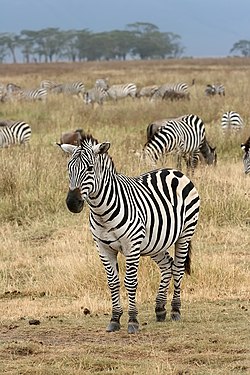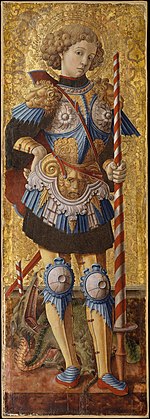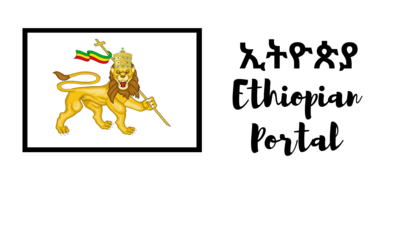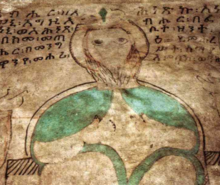Portal:Ethiopia
Introduction
Federal Democratic Republic of Ethiopia የኢትዮጵያ ፌደራላዊ ዴሞክራሲያዊ ሪፐብሊክ ( Amharic ) | |
|---|---|
| Anthem: ወደፊት ገስግሺ ፣ ውድ እናት ኢትዮጵያ (English: "March Forward, Dear Mother Ethiopia") | |
 | |
| ISO 3166 code | ET |
Ethiopia, officially the Federal Democratic Republic of Ethiopia, is a landlocked country located in the Horn of Africa region of East Africa. It shares borders with Eritrea to the north, Djibouti to the northeast, Somalia to the Northeast, East and Southeast, Kenya to the South, South Sudan to the West, and Sudan to the Northwest. Ethiopia covers a land area of 1,112,000 square kilometres (472,000 sq. miles). , it is home to around 128 million inhabitants, making it the 13th-most populous country in the world, the 2nd-most populous in Africa after Nigeria, and the most populated landlocked country on Earth. The national capital and largest city, Addis Ababa, lies several kilometres west of the East African Rift that splits the country into the African and Somali tectonic plates.
Selected article -

Urbanization of
Selected biography -
General images -
-
Tsegaye Gebre-Medhin in 1980s one of Ethiopia's renowned writers (from Ethiopia)
-
Fasil Ghebbi, one of the key castles of the Gondarine period. (from Ethiopia)
-
Entrance of Addis Ababa University (from Ethiopia)
-
Development of GDP per capita (from Ethiopia)
-
Köppen climate classification of Ethiopia (from Ethiopia)
-
Sheger Park is the largest park in the country, hosting hundreds of thousands of visitors a year since its opening (from Ethiopia)
-
Addis Ababa seen at nighttime, the financial epicenter of the country (from Ethiopia)
-
An Orthodox bible dated at least 1,500 years, being the oldest illustrated bible in the world, depicts Corinthian pillars (from Ethiopia)
-
House of Peoples' Representatives is the lower house of the Ethiopian Federal Parliamentary Assembly (from Ethiopia)
-
TheEthiopian Broadcasting Corporation former headquarters in Addis Ababa (from Ethiopia)
-
Ethiopian troops sent by the government under the Emperor Haile Selassie I during the Korean War fighting for South Korean independence (from Ethiopia)
-
Ethiopian Prime Minister Meles Zenawi (bottom row, fourth from left) in G8 Group meeting in 2007 (from Ethiopia)
-
An Ethiopian logistics shipping cargo docked at the Red Sea (from Ethiopia)
-
Ethiopian civil conflict: territorial control as of September 2023 (from Ethiopia)
-
The Addis Ababa Science Museum of Art and Science serves as the country's biggest hub which showcases the country's newest innovations (from Ethiopia)
-
A Homo sapiens idaltu hominid skull (from Ethiopia)
-
TheAxumite stelae in the northern part of Ethiopia, dating well over a thousand years, serve as a remembrance of Ethiopia's past architecture. (from Ethiopia)
-
Relief map of Ethiopia (from Ethiopia)
-
The Church of Saint George, Lalibela a pilgrimage site for Ethiopian Orthodox Tewahedo Church; the site is part of the UNESCO World Heritage Site "Rock-Hewn Churches, Lalibela". (from Ethiopia)
-
The Blue Nile falls during winter provides over 86 percent of the Nile river's water coming from melted snow in the Simien mountains below 0. (from Ethiopia)
-
Cultural performance in Addis Ababa (from Ethiopia)
-
Mengistu Haile Mariam was sentenced to death in absentia for committing crimes during his rule (from Ethiopia)
-
)
-
A Walia Ibex in Simien Mountains National Park, one of the national symbols of Ethiopia only found in the Northern parts of the country (from Ethiopia)
-
Declining child mortality in Sub-Saharan Africa and Ethiopia since 1950 (from Ethiopia)
-
The Empire of Axum at its peak in the 6th century. (from Ethiopia)
-
Olympic gold medalist (from Ethiopia)
Related portals
Geography
Countries
WikiProjects
Main WikiProject
Related WikiProjects
Africa • Countries • Eritrea • African military history task force
Things you can do
- Visit the Ethiopian Wikipedians' notice board.
- The noticeboard is the central forum for information and discussion on editing related to Ethiopia.
- Comment at the Ethiopian deletion sorting page.
- This page lists deletion discussions on topics relating to Ethiopia
Selected pictures
-

The plains zebra (Equus quagga, subspecies Grant's zebra pictured) is the most common and geographically widespread species of zebra. It ranges from the south of Ethiopia through East Africa to as far south as Angola and eastern South Africa. The plains zebra is mid-sized, smaller on average than the other two zebra species, and thick-bodied with relatively short legs. Adults of both sexes can stand from 1.1 to 1.47 m (3.6 to 4.8 ft) high at the shoulder, are 2 to 2.5 m (6.6 to 8.2 ft) long (excluding the tail), and weigh 175 to 387 kg (386 to 853 lb), with males slightly heavier than females.
Photo credit: Muhammad Mahdi Karim -

The black-chested snake eagle (Circaetus pectoralis) is a large African bird of prey in the family Accipitridae. It resembles other snake eagles and was formerly considered conspecific with the short-toed and Beaudouin's snake eagles, to which it is closely related. As well as feeding on snakes, which may be swallowed while still alive, it feeds on lizards, small mammals, frogs and insects. It typically perches in an elevated position ready to swoop silently to capture its prey, before returning to its perch to eat.
Photo credit: Charles J. Sharp -
American Colony, Jerusalem
-

The black-headed lapwing (Vanellus tectus tectus) is a resident breeder located across sub-Saharan Africa, living in locations ranging from Senegal to Ethiopia.
Photo credit: Charles J. Sharp -

Saint George (died 23 April 303) was a soldier of Cappadocian Greek origin. A member of Roman emperor Diocletian's Praetorian Guard, he was sentenced to death for refusing to recant his Christian faith. He is immortalised in the legend of Saint George and the Dragon and his feast day is celebrated on 23 April. Saint George is claimed as their patron saint by England, Ethiopia, Georgia, Catalonia and several other nation states, as well as by various cities, universities, professions and organisations.
Painting credit: Carlo Crivelli
Did you know -

- ... that the government of Ethiopia's SNNP Region supported local governments calling for a referendum to secede from the region?
- ... that Quintin Johnstone advocated giving control of an American-governed law school to native Ethiopians?
- ... that Asfaw Yemiru's school educated over 120,000 Ethiopian students?
- ... that medieval Ethiopian kings claimed to be descended from Solomon?
- ... that Aguil Chut-Deng took 22 child refugees from South Sudan to Ethiopia during civil war so that they could attend school?
- ... that Liberian paramount chief Tamba Taylor worked as a tailor and claimed to have sewn clothes for Ethiopian emperor Haile Selassie and Ghanaian president Kwame Nkrumah?
In the news
- 12 April 2024 – War in Amhara
- Two Fano militants are killed and a third is arrested during a shootout with police near the Millennium Hall in Addis Ababa, Ethiopia. A civilian is also killed and two officers are wounded. (The Washington Post)
- 9 April 2024 –
- The United Nations' International Organization for Migration reports that 38 people died when a boat, which has carried around 66 Ethiopian migrants, has sank off Godoria, Djibouti, a day before while on its way to Yemen. At least six more are still missing and presumed dead. (AFP via South China Morning Post)
Categories
Topics
Other Ethiopia-connected Wikipedias
Wikimedia
The following Wikimedia Foundation sister projects provide more on this subject:
-
Commons
Free media repository -
Wikibooks
Free textbooks and manuals -
Wikidata
Free knowledge base -
Wikinews
Free-content news -
Wikiquote
Collection of quotations -
Wikisource
Free-content library -
Wikiversity
Free learning tools -
Wikivoyage
Free travel guide -
Wiktionary
Dictionary and thesaurus
Other portals





































































